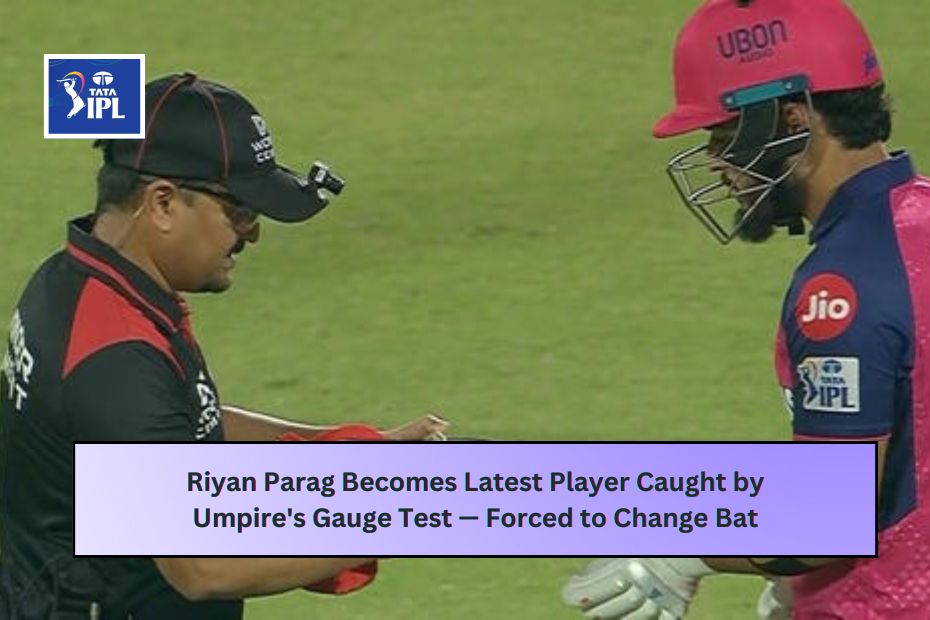During a thrilling IPL 2025 clash between Rajasthan Royals (RR) and Delhi Capitals (DC) at the Arun Jaitley Stadium, young batter Riyan Parag found himself in an unexpected controversy — but not over a shot, a dismissal, or a run-out.
Instead, Parag became the latest player to fall victim to the BCCI’s new bat-size gauge rule.
⚡️ What Happened in the Match?
While chasing a target of 189 runs, Rajasthan Royals’ skipper Sanju Samson injured himself on the last ball of the 5th over while trying to play a hard-hitting swipe off Mohit Sharma.
- Samson tried to shake off the injury and even consulted with the physio.
- However, the pain was too much, and he retired hurt.
- Riyan Parag came in as his replacement.
But as Parag stepped onto the field, ready to take strike, the on-field umpire suddenly stopped him. Why? His bat didn’t pass the new gauge test.
🪓 What Is the Bat Gauge Test?
The bat gauge test is a new rule introduced by the Board of Control for Cricket in India (BCCI) for the IPL 2025 season. This test ensures that every bat used on the field complies with strict size regulations — particularly regarding thickness, width, and edge size.
The bat must be able to slide through a standardized metal gauge (a sort of measuring frame). If the bat fails to fit through the gauge, the player is not allowed to use it.
🧑⚖️ How the Rule Works:
- Before openers take the field, their bats are checked by the fourth umpire.
- For any new incoming batter, the two on-field umpires check the bat using the same gauge before the batter takes guard.
This rule is designed to prevent players from using bats that exceed allowed dimensions — which could give them an unfair advantage, especially in a power-hitting game like T20 cricket.
🚨 Riyan Parag’s Situation
When Parag’s bat was checked, it failed to pass the gauge test. The on-field umpire immediately instructed him to change it before he could face his first ball.
Visibly surprised and a bit frustrated, Parag was seen having a brief and passionate discussion with the umpire before complying and swapping out his bat.
🧑🏫 Why Did the BCCI Introduce This Rule?
The IPL is known for power-packed entertainment, especially big sixes. Over the years, bat manufacturers have improved bat designs to create thicker edges, more powerful sweet spots, and heavier blades — sometimes pushing the physical limits of what is allowed.
The BCCI and IPL authorities introduced this rule to maintain fairness between batting and bowling. The idea is to avoid situations where:
- Batters gain unfair power due to oversized bats.
- Bowlers are placed at a consistent disadvantage.
The rule was confirmed by Arun Dhumal, IPL Chairman, who said:
“The aim is to ensure that no player has an unfair advantage. We want a level playing field. The BCCI and IPL have always used the best technology to ensure the fairness of decisions and the integrity of the game.”
📋 Players Previously Caught by the Gauge Test
Before Parag, two other notable IPL players had also fallen afoul of this new rule:
- Sunil Narine (Kolkata Knight Riders)
- Anrich Nortje (Delhi Capitals)
Both had to change their bats mid-match after their gear failed the gauge test.
💡 Conclusion: Fair Play Above All
Riyan Parag’s bat being disqualified highlights the BCCI’s commitment to maintaining balance in a format that heavily favors aggressive batters.
The gauge test isn’t meant to penalize players but to ensure standardization — so every batter competes on equal footing, without relying on oversized equipment for extra power.
The BCCI wants the sport to stay true to its competitive nature, making sure both batters and bowlers are playing the game within fair limits.



